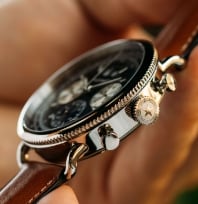Field Watches in WWI
A field watch is a simple military watch, originally called “trench watches” they were initially designed for soldiers to wear in WWI.
The first watches designed and manufactured on a broader level were field watches. Originally wristwatches were considered feminine, and some of the first wristwatches were intended for high seated women and were dainty and bejeweled. As wristwatches were considered too delicate for a man’s life, pocket watches were the only way for a man to wear a watch without ridicule.
Uniforms began changing as we headed towards World War I, and waistcoats became a thing of the past, replaced by trench coats. Watches also became a necessary piece of military equipment due to the tactics that heavily involved being on synchronized time during trench warfare.
However, in the early stages of conception and manufacturing, the field watch can be traced back to German officers when the very first wristwatches were ordered to be manufactured for their navy. These watches were built to be worn near water, and had large dark dials with bright white numbers with metal cages on top to help protect the glass from shattering on impact.
The iconic field watch was initially designed to increase the accuracy of these WWI military tactics. Officers could now plan attacks down to the second to capture an enemy trench using well-timed heavy artillery, cavalry, and stealth.
WWII Standardized Field Watches
These design necessities came to a head in WWII when the U.S. Army issued contracts for the A-11. Later, in the early 1950s, it was replaced by the A-17 watch designs. These two designs, manufactured by Bulova and Elgin and Waltham, solidified the look of the field watch.
Accuracy, of course, was critical to executing these tactics, so a watch that only lost or gained 30 seconds a day was considered extremely accurate at the time. The A-11 also had to be dustproof, waterproof, and be able to withstand extreme temperature conditions. Stainless steel became the norm for the casing. In contrast, an adjustable and comfortable leather or canvas strap (the NATO) became standard due to its rugged durability and the affordability of swapping it out if it were to become damaged. The display needed to be easily readable in any condition, so the case would be substantial, and the face was high contrast. Enter the iconic white numbers on a black background.
In World War I, the military did not yet issue these watches, and they had to be purchased by the individual, so they were widely available in shops around the world.
By WWII, field watches were standard military issue and needed to be lightweight and easily manufactured with no extra fobs and bobs so it could be streamlined for mass production. You could not have your military watch get hung on your rucksack or sleeve. For that matter, it needed to be able to be worn over any sleeve or jacket to make it accessible.
Enter the NATO strap. The NATO strap was originally designed by British Special Forces to make a watch more durable during warfare. The watch needed to be more accessible to the wearer as it assisted the watch being worn over the sleeves of the trench coat. NATO straps are durable - usually made of sturdy nylon, dry quickly from exposure to water or sweat, and don’t wear down or soften over time, making them the most suitable option for daily warfare wear as well as the modern adventurer.
Check out our selection and variety of Jack Mason NATO straps that meld time tested strength with today’s style and functionality.
After World War II, there was an influx in the availability of the field watch in stores across Europe and the US. As it so often happens in history, wartime necessity produced a global shift, and what was suitable for the military became the standard at home. These watches not only changed warfare but changed watch wear as we know it.
The Modern Field Watch
The same style and inherent design still rings true for field watches today. In fact, not much has changed in the modern field watch besides the introduction of luxury components as the watch transitioned away from utility and into a multi-functioning everyday watch for the contemporary man.
The Jack Mason Solar Watch is a modern nod to the field watches of the past. It boasts a clean, classic field watch style, but with a stylish, updated finish. Its black watch face with emerald green accents are a tribute to the great outdoors while still maintaining the iconic field watch, high contrast face. Its solar recharging mechanism ensures that you will never be without access to time, and its 100-meter water resistance means that it will perpetually endure whatever your throw at it.
What Makes a Watch a Field Watch?
A field watch for all intents and purposes has a simplistic case. Typically the field watch has a high contrast face - a dark face with light-colored hands and includes only a few complications to assist the wearer in specific field related tasks. These tasks could be military or scientific, depending on the wearer and the watch’s purpose. Some field watches have zero complications at all. A complication simply means any additional function a watch may possess besides just telling time.
Want to read more about some of the complications mentioned below? Check out our post on racing watches that gives an in-depth look at a few common watch complications. <insert link to racing watch article>
Common complications for field watches:
- Tachymeter Bezel - A bezel that assists with measuring how many times one can complete a single repeating task per hour. Like running or driving a mile.
- Day-Date Display - A slightly more complicated date display includes the day of the week and day of the month.
- Triple Calendar - A triple calendar simply adds the month of the year to the date display.
- A Compass Bezel - Allows you to find the cardinal directions using the hour hand of your watch.
Some of the more advanced complications that could be included on a field watch:
- Moon phase - Displaying the monthly phases of the moon.
- Planetarium - An elegant alignment of the solar system.
- Equation of Time - Differentiates solar time from civilian time.
Most field watches do not include all or any of these complications due to its simplistic, iconic style. Still, you can find just about any combination of complications out there on the market that suit the needs of your inner adventurer and style.
With its roots in more simplistic technological times, its vast versatility, and never-ending classic, almost vintage style, the field watch remains one of the most popular watches on the market. Its utility and durability make it the best choice for weekend trekking over mountains or simply backyard exploring. Any watch connoisseur, new or seasoned, would be wise to add one or even two field watches to his growing collection.
Sources:
https://www.realmenrealstyle.com/guide-field-watches/
https://watchranker.com/field-watch/
https://www.gentlemansgazette.com/watch-complications-guide/









